
Ceiba is a genus of trees in the family Malvaceae, native to tropical and subtropical areas of the Americas and tropical West Africa. Some species can grow to 70 m (230 ft) tall or more, with a straight, largely branchless trunk that culminates in a huge, spreading canopy, and buttress roots that can be taller than a grown person. The best-known, and most widely cultivated, species is Kapok, Ceiba pentandra, one of several trees known as kapok. Ceiba is a word from the Taíno language meaning "boat" because Taínos use the wood to build their dugout canoes.

Lupinus, commonly known as lupin, lupine, or regionally bluebonnet, is a genus of plants in the legume family Fabaceae. The genus includes over 199 species, with centers of diversity in North and South America. Smaller centers occur in North Africa and the Mediterranean. They are widely cultivated, both as a food source and as ornamental plants, but are invasive to some areas.

Hepatica is a genus of herbaceous perennials in the buttercup family, native to central and northern Europe, Asia and eastern North America. Some botanists include Hepatica within a wider interpretation of Anemone.

The genus Pulsatilla contains about 40 species of herbaceous perennial plants native to meadows and prairies of North America, Europe, and Asia. Derived from the Hebrew word for Passover, "pasakh", the common name pasque flower refers to the Easter (Passover) flowering period, in the spring. Common names include pasque flower, wind flower, prairie crocus, Easter flower, and meadow anemone. Several species are valued ornamentals because of their finely-dissected leaves, solitary bell-shaped flowers, and plumed seed heads. The showy part of the flower consists of sepals, not petals.

Weberbauerella is a South American genus of flowering plants in the legume family, Fabaceae. It includes three species of perennial herbs or subshrubs native to coastal Peru and northern Chile. They grow in seasonally-dry tropical coastal forest, on sand or sandy hills. It was recently assigned to the informal monophyletic Dalbergia clade of the Dalbergieae.
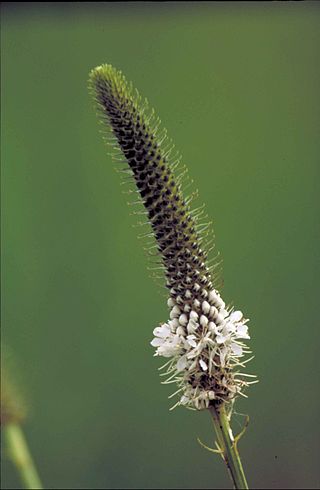
Dalea is a genus of flowering plants in the legume family, Fabaceae. Members of the genus are commonly known as prairie clover or indigo bush. Its name honors English apothecary Samuel Dale (1659–1739). They are native to the Western hemisphere, where they are distributed from Canada to Argentina. Nearly half of the known species are endemic to Mexico. Two species of Dalea have been considered for rangeland restoration.
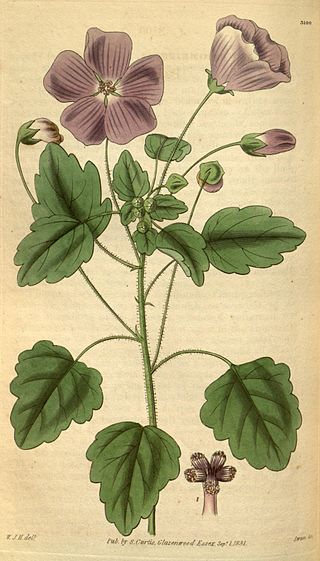
Palaua is a genus of malvaceous plants native to the Andes. It shares with Malope and Kitaibelia the property of possessing capitate schizocarps, and was formerly classified with them in a subfamily Malopoideae or tribe Malopeae. It is now considered to be more closely related to Sphaeralcea, and to other Andean mallows.
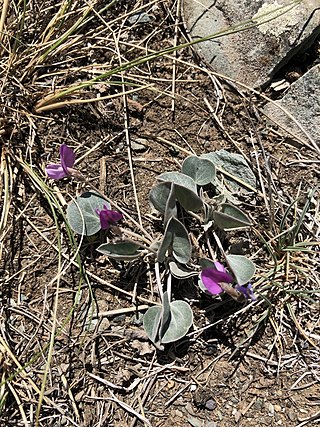
Gueldenstaedtia is a genus of flowering plants in the family Fabaceae. It belongs to the subfamily Faboideae. It includes four species native to Asia, ranging from India and Pakistan to Myanmar, Laos, China, Mongolia, and central Siberia.

The tribe Dalbergieae is an early-branching clade within the flowering plant subfamily Faboideae. Within that subfamily, it belongs to an unranked clade called the dalbergioids. It was recently revised to include many genera formerly placed in tribes Adesmieae and Aeschynomeneae and to be included in a monophyletic group informally known as the dalbergioids sensu lato. The members of this tribe have a distinctive root nodule morphology, often referred to as an "aeschynomenoid" or "dalbergioid" nodule.
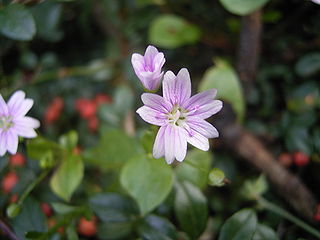
Montiaceae are a family of flowering plants, comprising about 14 genera with about 230 known species, ranging from small herbaceous plants to shrubs. The family has a cosmopolitan distribution.
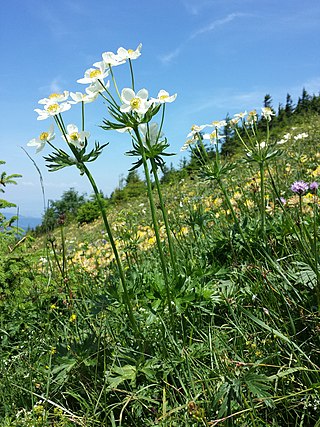
Anemonastrum is a genus of flowering plants in the family Ranunculaceae. Plants of the genus are native to the temperate and subarctic regions of North America, Greenland, Europe, Asia, South America, and New Zealand. The generic name Anemonastrum means "somewhat like anemone", a reference to the Anemone genus of closely related plants. It chiefly differs from Anemone in having a base chromosome number of x=7, as opposed to x=8.

Acaulimalva is a genus of plants in the family Malvaceae. It contains 21 species that are found in South America.
Urophysa is a genus of flowering plants belonging to the family Ranunculaceae.
Tetrasida is a genus of flowering plants belonging to the family Malvaceae.
Tarasa is a genus of flowering plants belonging to the family Malvaceae.
Anotea flavida is a species of flowering plant belonging to the family Malvaceae. It is the sole species in genus Anotea.
Cephalohibiscus peekelii is a species of flowering plant belonging to the family Malvaceae. It is a tree native to New Guinea, the Bismarck Archipelago, and the Solomon Islands. It is the sole species in genus Cephalohibiscus. It grows in lowland rain forests from sea level to 600 meters elevation.

Gaya is a genus of flowering plants belonging to the family Malvaceae. It has been classed in the Malvoideae subfamily and the Malveae tribe.

Weberbauerella chilensis is a legume species taxonomically similar to W. brogniartiodes; with a prostrate habit and shorter leaflets.

Weberbauerella raimondiana is a South American species of flowering plant in the family Fabaceae.















